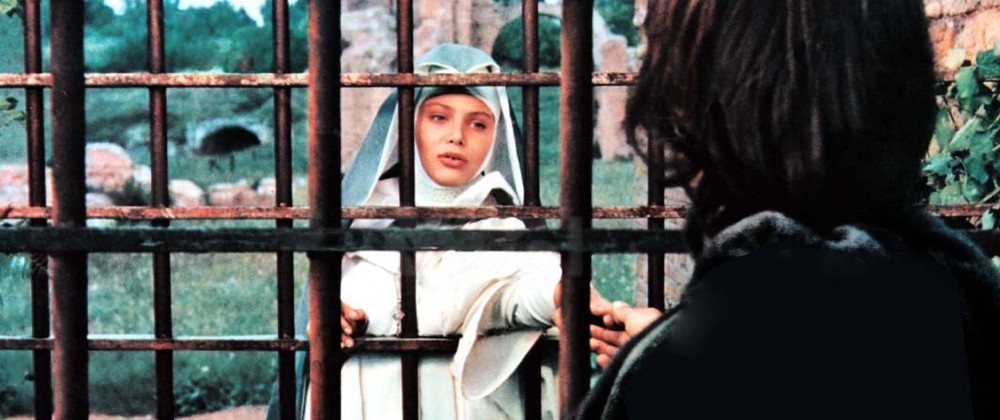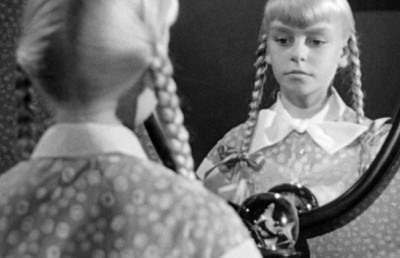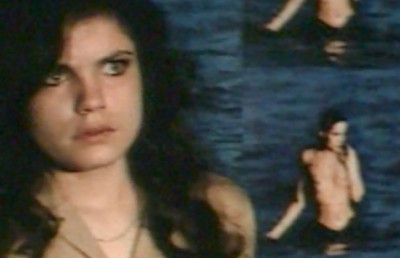Nunsploitation: The Forgotten Cycle

The European nunsploitation film is a minor cycle of exploitation cinema that has largely been critically ignored. Films such as Story of a Cloistered Nun (Domenico Paolella, 1973), Love Letters of a Portuguese Nun (Jess Franco, 1977), and Behind Convent Walls (Walerian Borowczyk, 1978), use the experience of women thrown together in the hostile and confined space of the convent to explore themes such as religious zealotry and sexual and social oppression. Like other European exploitation genres such as the Spaghetti Western, the Giallo, or the Euro War movie, the films began to appear in the mid to late 1960s and taper out as the 1980s began.
For the Spaghetti Westerns and the Giallo thrillers, critical appraisal was initially slow to develop, though Sergio Leone’s Dollars trilogy had an immediate and profound stylistic influence on American westerns of the late 1960s and early 1970s. Brian De Palma’s Sisters (1973) and Dressed to Kill (1980) are imbued with similar Hitchcockian narratives as many of the Giallo films are. Kim Newman in Nightmare Movies highlights how a kind of symbiotic relationship between the Italian exploitation films and American genre cinema existed at the time that extended beyond the Western or the Giallo, and that the relationship between the two was not of one sided imitation;
There is still a tendency to overlook the way Italian spectacles, horror films, murder mysteries, science fiction pictures, superspy pictures and jungle adventures do exactly the same things with the trappings of their Hollywood models that Leone does with the legacy left him by John Ford, Budd Boetticher and Anthony Mann. While many Italian genre films are simply worthless carbon copies with a few baroque trimmings, the best examples of most cycles are surprisingly sophisticated mixes of imitation, pastiche, parody, deconstruction, reinterpretation and operatic inflation. (Newman, 1988:188).
For the Italian nunsploitation movies this critical respect or even acknowledgement of their worth has yet to appear. Indeed, Newman leaves out the nun pictures from his roll call of Italian genre films of the 60s and 70s. They are excluded and marginalised even from the disrespected genres he lists. Why does this marginalisation occur? One explanation is that they emerge as descendants of two British art films rather than American dominated genres like the western, horror film, or war movie. Many of the films appear to superficially recycle themes from the two more famous convent set films, Powell and Pressburger’s Black Narcissus (1947) and Ken Russell’s The Devils (1971).
Also, and more crucially, at first glance the uninitiated and unprepared viewer could be distanced by the range of often lurid and alarming visual compositions and seemingly erratic mise en scene of the average nunsploitation film. The films are thought of as pornographic and dirty, and are therefore treated as such. A possibly apocryphal anecdote, reported in Action , the Director’s Guild of America magazine, concerns John Ford’s astonished reaction to the news that Italians were making westerns around the time Leone’s films made their international breakthrough. When he asked what they were like he was told that they had “no plot, no story, just killing”. A more articulate and accurate analysis can be attributed to Sir Christopher Frayling: “The classic Hollywood Western had been turned…[by the spaghettis]…into in your face close ups of rugged faces, twitching hands and fetishized weaponry, maleness as spectacle and style” (2006: xvi). In a similar way that the base elements of the Spaghetti Western can be focused on and used to conflate all films of the genre and disguise each film’s subtleties, it could be tempting to discuss the nunsploitation cycle as merely a barrage of images of female masturbation, lesbianism, the unrolling of stockings, nude floggings, and conspicuously sexual torture.
But, as with the Spaghetti Western, the lower order of the films in the cycle may fall prey to these basic criticisms, but by nature of the binary clashes they contain – conflicts of order and disorder, the feminine against the masculine, church or state against the individual – they all have something vital to say. Bev Zalcock in Renegade Sisters , her study of the representation of girl gangs in cinema, writes that “as the bearers of a simmering, sometimes delinquent sexuality, these sisters are constantly on the precipice of revolt. And while ostensibly the image of the nuns serves as a measure of morality, her plight historically is also a measure of the misogyny underpinning patriarchal society” (2001: 156). The best films of the cycle are equal to the highly political, left wing Spaghetti Westerns of Sergio Solima, Damiano Damiani and Sergio Corbucci, all of which are now given a certain measure of critical appreciation and understanding, initially through the ground breaking work of Sir Christopher Frayling, and up to the recent Radical Frontiers in the Spaghetti Western by Austin Fisher, which examines the political tendencies reflected in the films of the directors above.
Beyond the conspicuously erotic imagery that pervades the nunsploitation cycle, many of the films go beyond the pornographic to explicitly address themes of anti-capitalist politics, feminism and the historical treatment of women, and sexuality and its necessity to the human spirit. Furthermore, rather than being low rent, amateurish productions, they are often well crafted, serious pictures, made with the eye of real artists. Two nunsploitation films stand out as being exemplars of the cycle’s importance and quality: Domenico Paolella’s The Nuns of Saint Archangel (1973), and Gianfranco Mingozzi’s Flavia, the Heretic (1974).
The Nuns of Saint Archangel (also sometimes marketed as Nun and the Devil , which is confusingly also the title of a later 1978 Joe D’Amato nunsploitation film) is a clear critique of power structures, institutions and organisations. The film is about a power struggle in the convent to appoint a new Mother Superior while the present one lies dying of old age. The film is set in the 16th Century and one nun, Mother Giulia, is the favourite to be placed in charge of the order by the Church because she comes from an aristocratic family. If appointed, the Church will be rewarded by being given increased landholding rights, and a share of the profits from the exploitation of a new gold mine that the family has recently acquired in the ‘New World’. Here the personal ambitions of a corrupt woman are linked to the exploitations and corruption of both the Church and proto capitalists. In one scene, when discussing whether it is possible to install Mother Giulia as the Superior, the clear and very definite statement of the film’s stance towards the Church is made explicit when one character states “when it is a question of increasing their landholdings, the Church never says no”.
When Mother Giulia poisons the ailing current Superior to help quicken the entire process, an inquisition is triggered; this is presented as being even worse than the crimes it investigates and is blatantly misogynistic in its zeal. As in Ken Russell’s The Devils the chief inquisitor uses the alleged corruption as an excuse to punish any transgression of the convent’s rules. The nuns are punished via a series of graphically presented, highly invasive tortures. These include the use of the Judas Cradle (a hideous device used to torture the genitals), liquid being forced into the throat, and the use of thumbscrews.
Throughout the film the mise en scene is highly controlled and austere. It is a very grey film, and the convent appears as if shot in black and white, with the black and white of the nuns’ habits the dominant shades. There is a theatrical element to the staging, as if the film is composed of a series of tableaux shots and achingly slow tracking shots; these mirror the slow pace of convent life, as does the organ music, which plays almost constantly on the soundtrack.
Paolella presents life in the convent as a series of controlled rituals which alter, rearrange, and reimagine the femininity of the women in the order. These include a virginity test on a novice nun (checking that the hymen is in place) and the women’s hair being cut short. As they enter service it is literally stated that the women are entering a marriage to God. Each one works to erode the freedoms and natural state of the women who enter. These rituals are intercut throughout the film with tiny gestures of defiance and failures to conform in a manner that makes the film resemble a traditional prison movie (and not necessarily a Women in Prison movie either). These little moments are not always displays of outright rebellion, but are exhibited as natural human behaviour, for example, expressions of love, such as clandestine kisses. In one case the forced suppression of these desires (which are suppressed by external forces) results in one nun self-harming. Paolella makes a clear correlation between the suppression of desire and the destruction of the human spirit. The furtive affairs displayed in the film are of both the hetero and homosexual variety. The lesbian affair here is not an indicator of perversion or warped desire, as homosexuality often is in some films in the Giallo genre, but is presented as a perfectly natural expression of love.
The mise en scene shifts from the austere to the baroque during the inquisition scene, though it is less wild than in the equivalent scenes in The Devils . There is a touch of Grand Guignol staginess and excess to the torture scenes. They are presented in lengthy takes, oscillating between wide shots of the elaborate tortures and close ups of the nuns’ faces. The effect of the close ups is that they emphasise the sense of injustice by foregrounding the human misery and, far from being salacious, actually downplay the erotic potential of the torture by removing much of the nudity from the frame. Additionally, for the first time in the film there is a direct surge of colour, with the red of the inquisitor’s cloak the prominent hue. The pointed hoods worn by the inquisition torturers recall the Ku Klux Klan, bringing to mind the racist red hooded villains in Sergio Corbucci’s Django (1966).
The positioning of the inquisition and its victims is key in this instance. In his exhaustive examination of the wayward and ‘naughty’ nun archetype across culture Steve Fentone states that the film “mainly comments on the misuse of religio-political authority for capitalist ends” (2000:124). It is not the corrupt church officials, the proto capitalists, or indeed any men who are punished here, but exclusively the women. It is the behaviour of those who have the least power which is penalised, not those who make the rules. The aristocrats (whose decadence is reflected in the wearing of an outrageous coat made out of the fur of a wolf), benefit regardless of the outcome of the inquisition. The Church still receives its land and the exploitation of the mine in the ‘New World’ goes ahead as planned. Business prevails.
During the scenes of the inquisition’s final judgement, Mother Giulia is allowed to keep the title of Mother Superior despite receiving a death sentence, because doing so ensures the Church gets its prize. But just before her death she reveals, perhaps unwittingly, a libertarian subtext. As she provides explanation for her behaviour she espouses the entire anarchist philosophy when she exclaims — “the laws [of the church] are inhuman, and they made me inhuman too.”
Throughout, the film displays binary clashes; rules against freedom, and expressions of sexual desire against self-denial. These binaries can be seen within the Church and the State in the film. Both are working together towards the same ends, with foundations built on exploitation, slavery, and profit. And these sinister aspects are contrasted with simple human needs such as passion, the yearning for spirituality, and love. The drive for profit expressed by the Church is presented as being totally exclusive from the desire for human connection.
Gianfranco Mingozzi’s Flavia, the Heretic is the most notorious of the Italian nunsploitation films. An examination of the alternative release titles give some indication of both the international marketing strategy used for this film and indeed how other films in the cycle are viewed. Various international release titles for the film include Flavia , Priestess of Violence ; The Rebel Nun ; Flavia, Defrocked ; Flavia , Skinned Alive ; and Nuns put to Bloody Torture , all highly salacious titles tempered somewhat by the slightly more conservative Flavia, the Nun , its title in the Netherlands (2000:88). These highlight the unique aspect of the film. Like other movies in the genre, it illustrates, through its content and visuals, the injustices of power institutions, but Mingozzi’s film also has a central character who actively faces these injustices head on. The mise en scene centres on violent, carnivalesque imagery, with the inclusion of sequences of dreams and visions. However, the film features as many helpless males amongst the victims of violence as there are female.
The plot allows a young nun called Flavia to rise against her oppressors. She openly questions patriarchal society and the Church’s role within it. The subversive ideas run through the film constantly, and are persistently reinforced through the dialogue and every aspect of the visuals. The film’s libertarian stance is supported by the dialogue; “Why should men decide everything?” Flavia asks reasonably at one stage. The concept of personal liberation is also addressed, “What if a woman decided to go beyond her boundaries?” She asks. These two questions are the starting point for the character’s journey.
Flavia rejects life in the convent and joins a band of marauding Saracens, and she actively takes part in violent and pillaging raids on Christian towns and establishments, including her own convent. Ultimately she also rejects the Saracens, deciding that since the Muslim faith is also patriarchal in its basis, marrying into it would be replacing one tyranny with another. For this she is sentenced to death by being skinned alive.
The origins of Flavia’s rebellion are in the opening scenes, when members of a ‘Tarantula Cult’ run amok in the convent. The ‘Tarantula Cult’ was a real subsection of Christianity which offered sensual excess and orgiastic behaviour as a door to spirituality, as opposed to the traditionally rigid order of Church ritual. The film opens with a display of their wild, masturbatory conduct, and throughout Mingozzi fills the film with subversive and violent images; in one sequence a naked nun sits in the cut open and suspended carcass of a horse, with the help of two naked men; in another a nun is laid out on a table for other nuns and men to paw over. Again, in keeping with the carnivalesque nature of the scenes, all are naked. Unlike the slow, almost rigid style of Paolella, Mingozzi lets the images run riot. There are a series of direct reversals and parallel actions throughout the film. At the beginning we see the orgiastic excess of the ‘Tarantula Cult’, and later Flavia drugs the rest of the Sisters in the convent to ensure they lose their inhibitions and act in a similar way. Another early scene shows a passive Flavia witnessing the rape of a farm girl by a nobleman and she does nothing but walk away. Later this scene is reversed when Flavia captures the rapist and has him sexually violated, first by the farm girl, and then by a gang of Saracen soldiers.
The film is unique in that the overt eroticism that is inherent in the cycle is persistently undercut. The sex scenes are aggressive and brutal and the scenes of flogging are not eroticised sado-masochistic scenarios but painful punishments. The scenes of helpless and violated men are perhaps the film’s most singular quality. The sheer range and consistency of the images of men being the victims of sexual aggression is perhaps remarkable in all of cinema. Alongside the aforementioned scene of revenge against the rapist nobleman, there is also a monk being lowered from a harness and impaled through the rectum on a spike, and a scene where the elderly Mother Superior mocks the inferior genitals of another cowardly monk as he flees from the invading Saracens. The sexually violent threat to the male — the symbolism of castration or loss of power — is given a literal interpretation during a scene in which a horse is gelded on screen, and in reality. The inclusion of this bloody, genuine footage of a castration makes the image which appears later in the film, a close up of candles being sliced up, seem far more poetic and symbolic in comparison.
The libertarian subtext is revealed via the embracing of earthly desires and needs as a source of emancipation. There is an idea that it is this very notion of Flavia as a free spirit that makes her a blasphemous heretic and her deviation from following a traditional societal role makes her a challenge to authority. We see her being sexually autonomous, urinate publicly, willingly become intoxicated, and reject all forms of religious authority.
Like in The Nuns of Saint Archangel the film presents the rituals of entering a life of service. Mingozzi intercuts Flavia’s preparations for marriage to the Saracen chieftain with images of her being prepared for a life in the convent. The dehumanising, restricting nature of the convent is clearly being compared as an institution to marriage. Both are oppressive, and ultimately Flavia rejects each of them.
Mingozzi’s and Paolella’s films are not the only films of the cycle to transcend their exploitation trappings to deal with vital themes. Walerian Borowczyk’s Behind Convent Walls eroticises the convent and the rules of the order, and deals with the effect that a life of religious service has on the sexual development of young women. Bruno Mattei’s The Other Hell (1980) is a violently iconoclastic horror film which features liberal amounts of blood splashing nun’s habits, a priest being burnt alive, and reanimated zombie nuns.
The nunsploitation cycle is a hidden one. It is barely discussed even amongst those academics and critics whose research covers horror, exploitation, and the cult movie. Though Flavia, the Heretic and The Nuns of Saint Archangel get occasional dvd re-releases the cycle has avoided the renewed popularity of other exploitation sub genres. The company that re-released several nunsploitation titles in the UK in the 1990s, Redemption, even took the undignified step of including innuendo and jokes in the blurb on the back covers, an indication of how seriously the films were taken even by companies profiting from them. In a sort of postscript for the genre the head of Redemption, Nigel Wingrove, also made his own nunsploitation films; the 18 minute Visions of Ecstasy (1989), and feature length Sacred Flesh (2000), hinting at the lack of reach the nunsploitation cycle has. That Visions of Ecstasy became the only film in Britain to be banned for blasphemy, (and only got a BBFC certificate in 2012) tells us that there is an enduring power to some of the themes inherent across the cycle.
In contrast, the American Women in Prison films of the 1970s, such as The Big Bird Cage (Jack Hill, 1972) and Black Mama, White Mama (Eddie Romero, 1973) have been re-released numerous times in different formats, and have been written about far more frequently, including the work written by esteemed feminist film academic Pam Cook in Exploitation Films and Feminism (1976) and a chapter by Henry Jenkins in his book The Wow Climax .
Like other genre films, it is possible, should the viewer so decide, to reduce the nunsploitation film to its base elements. It takes a mature mind to treat the films seriously and look beyond the erotic to the themes underneath. It is important to remember that the films emerged predominantly from Catholic countries such as Italy in the 1970s. This was during the time of the Red Brigades and other moments of radical political upheaval and challenges to ideas of Western dominance. In parallel, the films present ideas that critique patriarchy and the church’s role in society, and draw attention to the links both have to capitalism. Therefore it is entirely appropriate to treat these films as being infused with radical ideas in the way that the political Spaghetti Westerns are.
Bibliography:
Cook, P Exploitation Films and Feminism , Screen vol.17, no. 2, Summer 1976
Fentone, S (2000) Anticristo: The Bible of Nasty Nun Sinema and Culture . FAB Press.
Fisher, A (2011) Radical Frontiers in the Spaghetti Western I.B. Tauris.
Frayling, C. (2006) Spaghetti Westerns: Cowboys and Europeans from Karl May to Sergio Leone . 2006 edition, I.B. Tauris & Co.
Jenkins, H (2006) Exploiting Feminism in Stephanie Rothman’s Terminal Island , The Wow Climax NYU Press.
Newman, K (1988) Nightmare Movies: A critical history of the horror film , 1968 – 88 Bloomsbury














